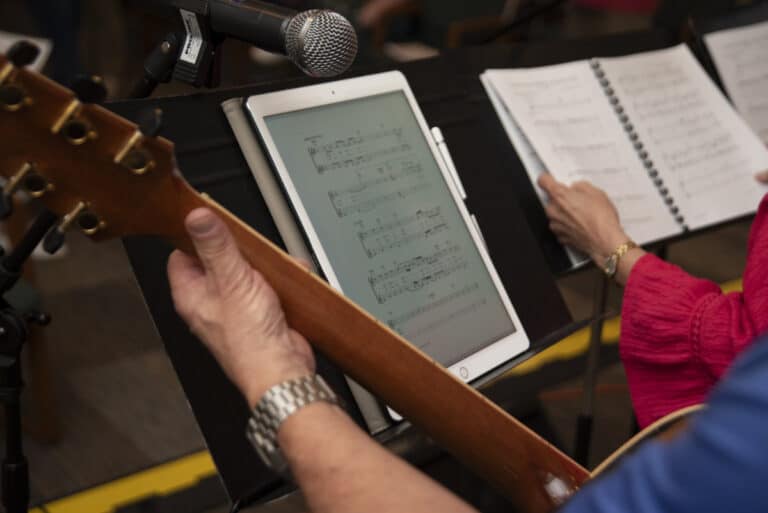Whenever groups of people work together, conflict can happen due to differences in perspectives, communication and coping styles, personalities, personal histories, beliefs about how things should work, etc. This is a brief look at understanding and handling conflict in ensemble music ministry.
Assess the situation
The first step is identifying the source and scope of the problem. Is it between two members, between a member and leadership, within a subgroup, or pervasive throughout the ensemble? Is it about differences within or about dynamics brought in from outside the ensemble from parish or community? Is it more like a quiet rumble of discontent or a spewing volcano?
Evaluate levels of trust
Our members join us with their life stories/journeys, hopes, expectations, and learned styles of coping with things (some adaptive, some not so much). This includes both current dynamics as well as long-standing issues. Trust is fundamental when it comes to handling conflict in ensemble music ministry. What makes it safe to talk about differences, big or small? Trust determines the degree to which one can suspend defensive reactions to hear and process feedback.
One size doesn’t fit all in these situations. You should have a sense of your own trust levels and history/comfort in dealing with conflict. Also have a sense of your member’s openness to it, often related to self-image and self-esteem. Someone with fragile self-esteem may hear a message of “this is something we might want to improve or do differently” as “you’re a failure and completely unlovable.”
For some, trust comes easy. For others the starting point is suspicion with trust to be earned. Some extend trust to authority, while others base trust on relationship. Some will trust until proven otherwise, while others are guarded until one proves trustworthy.
Approach the process mindfully
There’s no sense getting blindsided by something you might be able to predict and plan for, and approaching the process mindfully can help. Start with the primary actors in the conflict. This informs the choice of how to engage in challenging conversation, whether one-on-one, with a subgroup, or with the whole ensemble. When a choir member throws a tantrum in rehearsal about not getting enough solo time and storms out slamming doors, it certainly merits a one-on-one with the individual to clarify the expectations and standards plus a conversation in rehearsal to process the experience with those who were impacted by it as well.
Know your situation and authority
Is your pastor hands-on or hands-off about these things? Do they need to be involved in the decision-making, or just filled in afterwards? Would your parish staff meeting be a suitable place to discuss options and get support and direction? Not everyone has years of experience from running daily psychotherapy groups on locked psychiatric wards or doing mediations for the legal system with high-conflict clients to get comfortable with processing and containing the emotions of people in conflict. Getting support in dealing with such dynamics can be helpful. If you don’t find the process a little uncomfortable, you’re probably not paying attention.
Choose how to initiate the interaction
Text, email, phone call, letter, conversation? The more personal, the better. Acknowledge that there seems to be an issue and that you want to get their take on it. Meeting with an individual in a neutral location over coffee or lunch can be less intimidating. Finding out what is driving the conflict from each individual’s point of view can be crucial. Rarely does one side have the complete story.
Getting people in conflict together and refereeing the conversation can be critical. You can facilitate the conversation yourself if you’re seen as neutral enough and seen as caring about solutions or teamwork rather than putting someone in their place. If you are seen as part of the problem, a pastor or administrator may be a useful neutral party who can also bring a broader perspective.
Another factor in how you handle the conversation is the leadership style of the parish. Some trend more authoritarian with top-down decisions, while others are more democratic and allow for some shared decision-making.
Listen to understand
It’s often crucial for individuals or small groups who are unhappy with something to be listened to and have their feelings acknowledged (which is not the same as agreeing with those feelings or opinions). Sometimes this can lead to acceptable change. Whether the desired change is feasible or not, when people feel heard and respected, they are more likely to be accepting.
What rarely works with conflict in ensemble music ministry (or any conflict) is doing nothing and hoping that things resolve by themselves. When a conflict arises among the group, address the issue and work toward resolution using the steps outlined above.
If you would like some resources for further reading, here are several options to dive deeper into this topic:
- Beyond Reason: Using Emotions as You Negotiate. Fisher & Shapiro, 2005
- Difficult Conversations: How to Discuss What Matters Most. Stone, Patton & Heen, 1999
- Managing Music Ministry: Beyond Notes and Chords. Petrunak & Phillips, 2014
Written by Ken Gilman, PhD, a retired music director and an obbligatist on a variety of instruments – mandolin, bouzouki, violin, octave viola, bass mandolin, etc. As a semi-retired psychologist and mediator, he works with first responders on topics of teamwork, communication, and burnout.
Copyright © 2024 Catholic Liturgical Ensemble Formation
Looking for more resources? Search our full online library of CLEF Life resources, or sign up for CLEF Life email updates to receive the latest resource in your inbox once a week.



